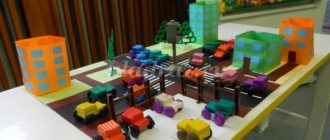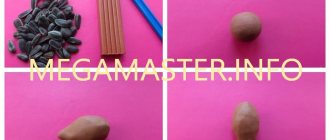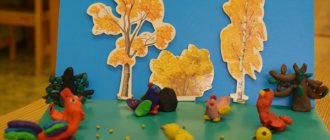“Acquaintance with the art of Gzhel painting”
MOBU "Secondary school s. Malinovo" joint venture kindergarten.
Notes on drawing for children of the senior group.
Educator: Mikhalchenko L.V.
Topic: “Introduction to the art of Gzhel painting”
Target:
acquaintance with the traditional Russian artistic craft “Gzhel ceramics” and mastering simple elements of painting (straight lines of various thicknesses, dots, grids, borders, droplets).
Tasks
:
Educational:
To acquaint children with the history of the emergence of folk art, to develop the ability to distinguish and name the elements of Gzhel patterns (roses, dots, stripes, nets, wavy arcs)
Summarize children's knowledge about folk crafts: Khokhloma, Gorodets, Dymkovo painting.
Developmental:
develop memory, thinking, creative imagination, expand vocabulary (ceramics, surroundings, Rus', craftsmen, firing, etc.; continue to develop children’s technical skills - skillfully use a brush (paint with the tip of a brush).
Educational:
to cultivate interest in the art of Gzhel masters, to cultivate the ability to evaluate the work of peers, to cultivate a love of folk art.
Integration of educational areas: “Cognitive development” “Speech development” “Artistic and aesthetic development”, Social and communicative.”
Vocabulary work:
Gzhel paintings, figurine, background, pattern, masters,
Preliminary work:
conversations about paintings, drawing based on folk paintings (Gorodets, Khokhloma, Dymkovo painting); asking riddles, reading poetry.
Material:
dishes with Gzhel painting, D/game “Collect the dishes” (“Shards of broken” Gzhel dishes), audio recording of Russian folk songs, samples of elements of Gzhel painting, gouache paints, palette. Gouache blue, white, brushes, napkins, jars of water, sheets of paper in the shape of a plate. Use of ICT.
GCD move:
(a Russian folk melody sounds quietly. I invite the guys to come closer to me).
Educator:
Guys, let's say hello and wish each other a good mood! And we wish the guests a good mood! These are the beautiful and smiling people I invite to class today. Children, do you like to travel? (Children's answers)
Today we will take a journey into the world of beauty, goodness, into the world of amazing creations of folk craftsmen. I warn you right away, it will be not only interesting, but also difficult. So, is everyone ready? And we'll go to
folk craftsmen into a blue-blue fairy tale. And why it is called that, you will understand for yourself (the children sit down, listen to the teacher’s fairy tale and look at the slides)
Educator:
It was a long time ago. In a certain kingdom, in the Russian state, not far from Moscow, among dense forests stood the village of Gzhel. Brave and skillful, kind and hard-working people lived there. And then one day they got together and began to think about how best to show their skills, please all the people, and glorify their land. They thought and thought and came up with something. They found wonderful, white, white clay in their little place, and decided to sculpt dishes the likes of which the world had never seen. They made a teapot and cups, saucers, and sugar bowls. The dishes turned out wonderful... They began to think. How to decorate such intricate dishes? They went home... They walked along the road and looked. And all around there is fabulous beauty, blue is spreading, blue, high blue sky with white clouds, in the distance a blue forest can be seen, the blue surface of rivers and lakes, and a white fog spreading over them. So they decided to transfer this blue to white porcelain. They painted patterns of flowers, droplets, stripes, and nets on the dishes. Each master began to show his ability. One master made a teapot, another a jug (showing works) Gzhel masters are great dreamers. They sculpted various animals and birds. Each artist has his own favorite pattern, and each one reflects the side of his birthplace - its silk grass, its spring flowers. And so it happened that each master pleased everyone with his skill. He taught his children and grandchildren various wisdom so that they would be good masters. Just one paint, but what an elegant and festive painting it turned out to be.
Abstract of OOD on drawing in the senior group on the topic: “Cup and saucer” (Gzhel)
Abstract of OOD on drawing in the senior group on the topic: “Cup and saucer” (Gzhel)
Educator: Egorova L.V.
Type of lesson: thematic, artistic and aesthetic.
Forms of educational activities: subgroup, individual. Goals: To develop the ability to create a pattern on a cup and saucer using Gzhel painting. Objectives: Educational:
Introduce children to Gzhel.
Learn to highlight the characteristic features of Gzhel painting, decorate the border of a cup with simple elements of painting (simple, wavy lines of varying thickness, dots)
Educational:
Develop a sense of color, rhythm, symmetry;
the ability to paint with a brush in different ways, to encourage creative initiative. Develop independence in decorating dishes. Educational:
To cultivate perseverance and accuracy when working with gouache. To form in children a holistic artistic understanding of the role of dishes in human life and the desire to make the surrounding objective world beautiful. Vocabulary work: pattern, tea pair, Gzhel, Gzhel, painting.
Planned results: The child is familiar with the characteristic elements of Gzhel painting, creates a pattern based on Gzhel painting (creates a pattern on a tea cup and saucer); knows how to paint with a brush in different ways (flat, with the end of the brush);
Shows creative initiative and independence in decorating tea utensils. Has an idea of tableware, its purpose, differentiates objects within the same type (tea, tableware, kitchenware, when examining an object, identifies parts as an identifying feature) Has a holistic artistic understanding of the role of tableware in human life and strives to make the surrounding objective world beautiful. Materials and equipment: dishes with Gzhel painting, sheets of paper with the silhouette of a tea cup and saucer, variable samples of the teacher, decorated with Gzhel patterns; brushes, gouache, napkin, sippy cup, doll. Preliminary work: examination of products with Gzhel painting. Conversation about dishes, looking at illustrations, looking at samples. Individual work: practice the ability to draw with a brush in different ways: with the end of the brush - thin lines, with the whole bristle - wide, pressing the brush to the paper - the “dip” method. Progress of OOD: 1. Organizational moment: “ Good morning”
Good morning! Smile soon, And the whole day today will be more fun! We will stroke your forehead, nose and cheeks, We will be beautiful, like flowers in the forest! Let's rub our palms harder, harder, now we'll rub our ears and save our health. Let’s smile again and say: “Be healthy, everyone.
2.Introduction to the problem situation.
Guys, the doll Tanya came to our lesson today
Look, she's sad. Why do you think?
Let's find out what happened to her? Tanya says that her friends should come to her tea party, but she was in such a hurry to set the table that she fell and broke everything. What should I do? How can we help her? 3. Updating children's knowledge
Guys, listen carefully to the riddles and guess what broke:
What kind of guy is this
In a blue and white shirt
Invites for tea
Porcelain cups
(Kettle)
How did you guess that it was a teapot? That he has? It has a spout, a handle, and a lid.
Everyone really likes her, She's a beauty on a silver platter, She's a cutie with one hand, Little blue (cup)
Unapproachable in appearance, Standing with her arms akimbo, But look inside, There is sugar inside, So this is (sugar bowl) Guys, how can you call all this in one word? Dishes. What utensils are needed for tea drinking? Teaware. Please name the items of tea utensils. Or What kind of tea utensils do you know? (Children's answers) Well done, guys, you answered correctly.
What do you think it was made of? ( from glass )
What other dishes are made of?
( Wood, glass, metal
)
Could wooden dishes break? ( No
)
What about plastic dishes? ( No
) What about glass?
( but
why? Our Tanya has a fragile, thin teapot. There is also tea in a box. But where can I get the cups? Help? Guests are already rushing to see her! How can we help Tatyana? (buy, sculpt, draw, paint)
Physical exercise “Teapot” (learning) Here is a large glass teapot (Inflated the tummy, put one hand on the belt, curved the other - “spout.”) Very important, like a boss.
Here are the porcelain cups, (They sat down and put one hand on their belt.) Very fragile, poor things. Here are the porcelain saucers, (They spin around, drawing a circle in the air with their hands.) Just knock, they will break. (They clap their hands, stomp.) Here are the silver spoons, (They stretched, clasped their hands above their heads.) The head is on a thin stem. Here is a plastic tray, (They bent over and stretched out.) He brought us the dishes. I take care of all the dishes (children lean forward, spread their arms to the sides), because I love them (hands on heart).
4. Difficulty in a game situation.
And I have cups and saucers, but they are not so beautiful white, without a pattern.
Don't worry, we will help you, we will decorate your cups. Guys, can we help? Ready? 5. Discovery of new knowledge and skills Explanation of new material.
What pattern do you think can be used to decorate tea cups and saucers? (flowers, leaves, stripes)
There are products from Gzhel on the board. (children look and admire)
The teacher reads poetry:
- Oh yes, the dishes, what a marvel, both this one and this one are good, All elegant and beautiful, painted, all in flowers! There is a rose, a chamomile, a dandelion, cornflowers, with a blue mesh around the edge, you just can’t take your eyes off it. They created this miracle not far away, they painted those dishes in Russia, in the village of Gzhel.
The edge of a porcelain miracle, and forests all around it. Blue-eyed dishes, like the skies in spring. Vases, teapots and dishes shine on the table! Eating with painted dishes is tastier and more fun!
—Where are these dishes made? ( in the village of Gzhel
) - That's right, in the village of Gzhel, not far from Moscow.
The teacher recalls the history of the appearance of Gzhel products:
“A long time ago, they found snow-white clay in those places, from which they learned to produce ceramic material - porcelain, and to sculpt and bake toys and dishes in the oven. And then paint the objects.
- What kind of dishes is this? How can you characterize it? ( beautiful, blue, elegant
)
Conclusion
: That’s right, the dishes are elegant, beautiful, festive.
- What makes this dish like this? ( she is blue, tender
)
— What color did the masters use?
Conclusion:
That's right blue. It is by the color of the paint and the pattern that we distinguish the products of this craft.
Look, the masters used various pattern elements: straight and wavy lines, arcs, dots, droplets, roses, curls)
What pattern elements did the masters use when painting them? (roses, circles, dots, lines: wavy, straight, thick, thin, long, short, flowers)
Can you please remind me which masters use these patterns? ( Gzhel)
Let's decorate white tea cups with a Gzhel pattern. Pay attention to the border around the edges of the dishes and border
it repeats rhythmically.
First, I will decorate the top of the cup - the border, then the middle of the cup - the flower, we will draw petals. We dip only the brush into the paint, do not stain the iron skirt with paint, draw the petals by dipping: one on the left, the other on the right, above, below.
How should the droplet petals be placed around the center to make a beautiful flower?
Conclusion:
Correctly, evenly, neatly.
Then I will decorate the bottom of my cup. The teacher draws a pattern with a brush, pays attention to the methods of working with a brush: with the end of the brush we draw thin lines, with the whole bristle we draw wide lines, pressing the brush to the paper we get petals - droplets and leaves (dip method) My cup is ready
.
I decorated this cup with this pattern, and you can come up with and decorate your cups with a pattern. Let's get our fingers ready for work.
Finger game: "Helpers"
One, two, three, four,
(alternating clapping hands and hitting fists against each other)
We washed the dishes:
(one palm slides over the other in a circle)
Teapot, cup, ladle, spoon
And a big ladle.
(bend your fingers one at a time, starting with the thumb)
We only broke the cup,
The ladle also fell apart,
The teapot's nose is broken.
We broke the spoon a little. (bend your fingers one at a time, starting with the thumb)
This is how we helped mom!
(rhythmic fist bumps and clapping)
6. Reproducing something new in a typical situation.
Let's paint our cups and saucers, the way the folk artists of Gzhel do it. Independent activity of children, individual assistance from the teacher. 7. Reflection (result) Exhibition of drawings. Everyone's cups and saucers turned out beautiful! This blue pattern is from Gzhel, It pleases everyone with its beauty. See if there are identical cups and saucers? No! Each of you was a real master and decorated your cup and saucer with a Gzhel pattern. Both the dolls and their guests will be happy with these cups and saucers.
Well done, all the masters!






